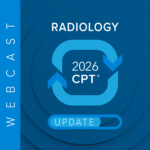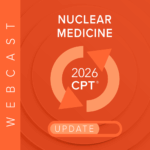Following the release of the Centers for Medicare & Medicaid Services (CMS) proposed Physician Fee Schedule (PFS) for 2026, outpatient evaluation and management (E&M) coding and documentation once again stand at the forefront of compliance focus.
The proposed updates build on the 2025 Final Rule, but introduce nuanced shifts that will directly influence how organizations document, code, and defend E&M services. For health information management (HIM) and clinical documentation integrity (CDI) leaders, this transitional period signals an urgent need to prepare for new audit triggers and strengthen data governance across outpatient care.
Understanding the Regulatory Shift
The CMS proposed PFS outlines two distinct conversion factors, one for qualifying advanced payment model participants and another for non-qualifying clinicians, reflecting the agency’s continued push toward value-based care. While both factors represent modest increases from 2025, the proposal also introduces a -2.5-percent efficiency adjustment for non-time-based services.
This change effectively reduces reimbursement for many procedure codes while leaving time-based E&M, behavioral health, and telehealth services exempt.
At the same time, CMS is proposing updates to the practice expense (PE) methodology, adjusting indirect cost assumptions between facility and non-facility settings. This could subtly alter reimbursement dynamics for outpatient clinics, hospital-based departments, and integrated care networks. The proposed rule also streamlines how services are added to the Medicare Telehealth Services List, signaling a long-term shift from temporary pandemic flexibilities toward a permanent regulatory framework.
Compliance Implications for Outpatient E&M
Each of these changes influences the way outpatient E&M encounters will be scrutinized in upcoming audit cycles. The focus is moving from volume-based review to documentation precision, particularly in how providers justify medical decision-making (MDM) and time reporting.
Take, for example, the longstanding comparison between CPT 99213 and CPT 99214. Under the 2023 E&M revisions, the distinction between these codes depends on MDM complexity or total time. Yet in many audit findings, providers still default to 99214 without fully supporting moderate MDM or documenting the exact minutes spent in patient care coordination. Under the new framework, wherein CMS is signaling increased audit oversight and efficiency expectations, these borderline distinctions will likely face heightened scrutiny.
Another emerging risk area is split/shared visits. Although CMS finalized its policy to allow either time or MDM to determine the substantive portion of a shared encounter, auditors continue to flag inconsistencies in documentation, particularly when the physician and qualified health professional record conflicting elements. As more organizations adopt ambient artificial intelligence (AI) or scribe technology to capture portions of these encounters, the need for explicit attribution and authentication becomes critical.
Where the 2026 Proposed Rule Raises the Bar
The 2026 proposal reflects the CMS commitment to linking payment integrity with documentation quality. Leaders should note that the rule’s efficiency adjustment creates a financial incentive for precise coding of time-based services, while practice expense realignments could shift audit patterns toward outpatient and non-facility settings. Additionally, the CMS renewed emphasis on data accuracy and audit transparency hints at closer collaboration between the U.S. Department of Health and Human Services (HHS) Office of Inspector General (OIG) and Medicare Administrative Contractors (MACs) in reviewing E&M claims.
In short, the proposed 2026 PFS is not just a pricing update; it’s a compliance signal.
Top Documentation Risks for 2026
As CMS sharpens its focus on documentation transparency, auditors are expected to concentrate on several interrelated risk areas throughout 2026. One persistent vulnerability involves incomplete time documentation, particularly for visits billed on total time.
Even minor omissions in recorded minutes can undermine the validity of a claim when time, rather than MDM, determines the E&M level.
Equally concerning are insufficient or vague medical decision-making (MDM) narratives. Records that fail to connect the patient’s problems, the complexity of data reviewed, and the overall risk profile often lead to downcoding or post-payment review. In an era of heightened efficiency adjustments, these weak MDM justifications could draw more frequent scrutiny.
As noted, auditors are also paying closer attention to split/shared visits, ensuring that the documentation clearly identifies which clinician performed the substantive portion of care. Ambiguous attribution, particularly in environments using team-based documentation, can quickly trigger compliance questions.
Telehealth services remain another high-risk category. Documentation must confirm that the encounter met CMS’s interactive audio-visual requirements and that patient consent was obtained. Missing either element can invalidate a claim, especially as CMS moves toward formalizing telehealth coverage criteria in the 2026 PFS.
Finally, the emergence of AI-assisted documentation introduces a new compliance frontier. As technology increasingly drafts portions of notes or suggests codes, organizations must ensure that human oversight remains intact. The final record must always reflect the provider’s clinical judgment, not the algorithm’s prediction, a principle that will define audit readiness in the coming year.
The Path Forward
For HIM and CDI professionals, the takeaway is clear: the 2026 Proposed Rule marks a turning point where clinical specificity, documentation validation, and operational compliance converge. This is the moment to re-educate providers on E&M leveling, refine audit templates to align with the proposed efficiency and expense adjustments, and validate what emerging AI or scribe technologies support, not obscure provider intent.
CMS’s proposal underscores that accurate documentation is more than a billing safeguard; it is a cornerstone of ethical, data-driven patient care. The organizations that treat these changes not as regulatory burdens but as opportunities to elevate quality will lead the next era of compliant, intelligent documentation.
Programming note:
Listen live on October 28 when Angela Comfort cohosts Talk Ten Tuesday with Chuck Buck at 10 AM Eastern.













